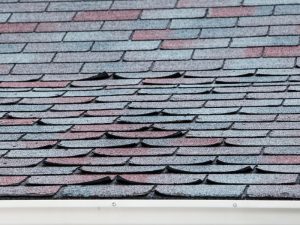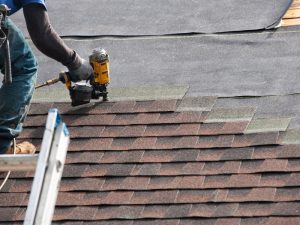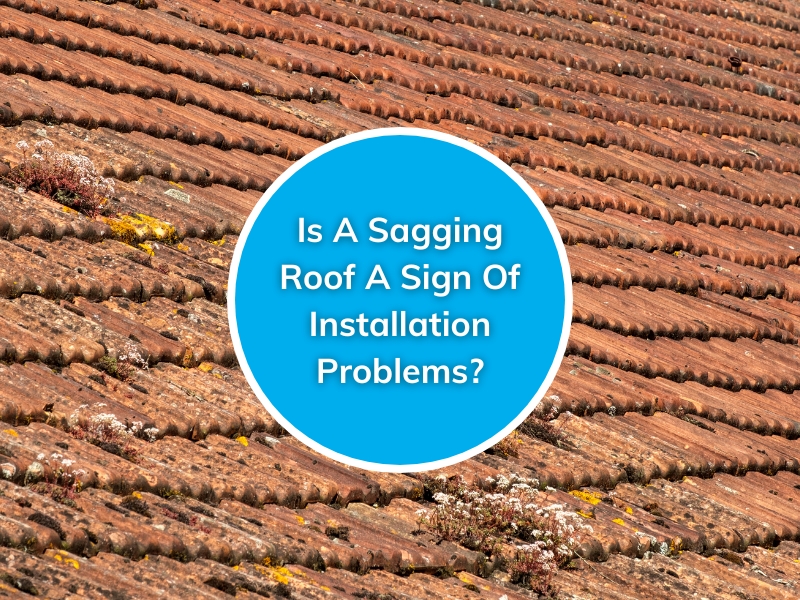Roof sagging is a common issue that homeowners may encounter. However, many homeowners are unsure whether roof sagging is due to wear and tear or a more serious issue from poor installation. Understanding what causes roof sagging and how to address it can help prevent long-term damage and costly repairs. This guide will provide insight into whether roof sagging relates to installation issues, the risks involved, and the benefits of professional roof services.
What causes roof sagging?
Roof sagging occurs when a roof structure dips or bows downwards. It is not only an eyesore but also a potential hazard to your home. Several causes of roof sagging exist, and they can vary in severity.
- Excess weight: Heavy loads on the roof, such as accumulated snow, large debris, or poorly placed solar panels, can cause the roof to sag over time.
- Water damage: Prolonged exposure to water, especially from leaks or clogged gutters, can weaken the wooden supports of the roof, leading to sagging.
- Improper support: If the roof is not installed with adequate structural support, it may not withstand the weight of roofing materials and environmental factors.
- Old roofing materials: As they age, they lose their strength and may no longer provide the support needed to keep the roof in place.
- Poor installation practices: Incorrect roof installation can lead to structural weaknesses, which may result in sagging over time.
Can poor installation lead to roof sagging?
Yes, poor installation can absolutely contribute to roof sagging. While roofing systems are designed to bear specific loads and withstand environmental pressures, improper installation can lead to a number of issues that cause the roof to sag.
- Incorrect materials: Using substandard or mismatched roofing can compromise the roof’s integrity.
- Improperly placed beams and supports: If beams are not placed at the right distances or are of insufficient strength, the roof may not distribute weight evenly, leading to sagging.
- Incorrect pitch: A roof with an incorrect slope or pitch will not shed water efficiently, leading to increased moisture retention, which can damage the roof structure.
- Inadequate ventilation: Poor ventilation can result in excess moisture, causing the wood to warp and weaken and eventually contribute to sagging.
When installing or repairing your roof, it’s crucial to ensure that all work complies with Australian Building Standards for residential roofs to guarantee safety, quality, and long-term durability.
How can you identify if your roof was installed incorrectly?
There are a few signs that indicate poor installation may have contributed to roof sagging:

- Visible sagging: If the roof appears to dip or bow in certain areas, it indicates something went wrong during installation.
- Uneven shingles: If the shingles are uneven or improperly aligned, this could indicate that the roof frame is not supporting them correctly.
- Leaks and water damage: Persistent leaks or water stains on the ceiling could be a sign of poor roof installation that allowed water to infiltrate.
- Poor drainage: Incorrect gutter or downspout installation, along with water pooling on the roof, can lead to structural damage.
- Cracked or warped beams: Beams or trusses that appear bent or cracked could be a sign of poor installation or low-quality materials.
What are the risks of ignoring roof sagging?
Ignoring roof sagging is not only a cosmetic concern, but it also presents significant risks to both your home and your safety:
- Structural damage: A sagging roof can eventually damage your home’s interior, including the ceiling and walls.
- Water damage: As the roof sags, leaks may develop that can lead to water damage in the attic, walls, or even the foundation.
- Increased repair costs: If roof sagging is left untreated, the repair cost and the associated damage will escalate.
- Decreased property value: A sagging roof can significantly reduce your home’s aesthetic appeal and market value.
- Safety hazards: Sagging roofs are structurally unsound and pose a risk of collapse, particularly during storms.
If you’re concerned about potential leaks, it’s important to understand how to detect roof valley leaks early, as these areas are prone to water accumulation and can lead to serious damage if left untreated.
How can professional roof installation prevent sagging?
A professional roofing service ensures that your roof is installed with the proper materials and techniques to prevent sagging:
- Expert installation: Skilled roofing experts will install your roof using the correct materials and techniques to provide lasting stability.
- Accurate load calculations: Weight distribution will be calculated by professionals to ensure the roof can support all loads.
- Proper ventilation: Adequate ventilation reduces moisture buildup, which is crucial in maintaining the integrity of the roofing structure.
- High-quality materials: Professionals use durable materials that can withstand environmental pressures without compromising the roof’s structure.
- Compliance with building codes: A professional roofing service ensures that all work meets local building codes, reducing the risk of issues like sagging caused by poor installation.

What role does regular roof maintenance play in preventing sagging?
Regular roof maintenance is essential in preventing sagging and ensuring the longevity of your roof. Maintenance allows for early identification of potential issues to be addressed before they cause significant damage.
- Routine inspections: Regularly schedule professional roof inspections to identify weak spots, leaks, or potential structural issues before they worsen.
- Cleaning gutters and downspouts: Clogged gutters cause water to build up. This extra weight on the roof can contribute to sagging.
- Repairs and replacements: Small repairs, such as replacing damaged shingles or fixing leaks, can prevent the roof from deteriorating further.
- Removing debris: Regularly clearing debris from the roof can help prevent the accumulation of weight that can lead to sagging.
To ensure your roof stays in top condition for years to come, be sure to learn more about the roof restoration process and how it can extend the life of your roof.
How do you know when it’s time for a roof replacement?
If your roof shows signs of sagging, it may be time to consider a replacement. Here are some indicators that replacement is necessary:
- Severe sagging: Extensive or worsening sagging may indicate severe structural damage.
- Multiple leaks: If your roof has multiple leaks, replacement might be more economical than repairing the damage.
- Age of the roof: Roofs older than 20 years often reach the end of their lifespan. This can increase their vulnerability to issues like sagging.
- Expensive repairs: If the cost of repairing your roof exceeds the replacement cost, it’s time to invest in a new roof.
- Increased energy bills: If your roof is not properly insulated or sealed, it can lead to higher energy bills. A new roof with proper insulation can improve energy efficiency.
For a reliable and seamless experience, consider opting for a professional roof replacement to ensure your home is protected with the highest-quality materials and expert craftsmanship.
Why choose a professional roofing service for your installation and repairs?
Choosing a professional roofing service guarantees high-quality installation and maintenance for your roof. Here are some key benefits:
- Skilled craftsmanship: Experienced roofing teams have the expertise to handle all roofing projects, ensuring quality work that stands the test of time.
- Comprehensive services: Professional roofing companies typically offer a range of services, from installation and repair to ongoing maintenance, tailored to meet specific needs.
- Customer satisfaction: A reliable service provider will focus on customer satisfaction, offering transparent pricing and guarantees on all work.
- Local expertise: Local roofers understand the area’s specific needs. They ensure their work meets local building codes and environmental conditions.
Get professional roof replacement from High Class Roofing today!
When it comes to roof replacement, trust is key. At High Class Roofing, we pride ourselves on providing a service that is not only professional but also affordable. Our team is known for being approachable, punctual, and reliable, making the roof replacement process seamless and stress-free. Clients find us easy to work with. We always strive to keep our promises and deliver quality results.
A recent client praised us for offering a reasonable price. They also appreciated our excellent communication and our consistent on-time arrivals. Additionally, they expressed their satisfaction with the service and stated they would keep our contact information for future roofing needs and recommend us to their friends.
Whether it’s time for a roof replacement or just a simple repair, High Class Roofing guarantees a smooth experience with skilled craftsmanship and top-quality materials. Contact High Class Roofing for a free inspection and experience our exceptional service for yourself!
Frequently Asked Questions
- Can roof sagging be repaired, or does it require a full replacement?
Depending on the severity, sagging can be repaired, but in some cases, replacement may be necessary.
- How can I tell if my roof has been installed incorrectly?
Look for visible sagging, uneven shingles, persistent leaks, or poor drainage.
- What are the risks of leaving the roof sagging untreated?
Risks include structural damage, water damage, higher repair costs, decreased property value, and safety hazards.
- How often should I get my roof inspected?
It’s recommended to have your roof inspected at least once a year or after major weather events.
- Can roof sagging affect my home’s insulation?
Yes, sagging can lead to gaps that compromise your home’s insulation, increasing energy costs.
- Does roof sagging always require professional help?
It’s important to consult professionals to assess the situation and determine the best course of action.
- Can poor roof ventilation cause sagging?
Yes, improper ventilation can lead to moisture buildup, which weakens the roof structure.
- What should I do if I notice sagging on my roof?
Contact a professional roofing service immediately to assess the damage and provide solutions.
- How much does it cost to replace a sagging roof?
The cost depends on the extent of the damage, the materials used, and the roof size. It’s best to get a quote from a professional roofing service.


